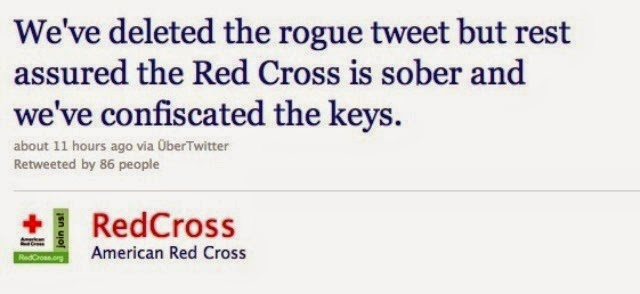Back in 2011, Gloria Huang was a young social media specialist working with the Red Cross. She also just so happened to be a fan of craft beer. Why does that matter? Well, with the simple push of the "post" button she let over 2 million fans of the Red Cross know of her passion for good beer and her penchant for getting "slizzerd" with her friends. The post was meant for her personal account.
Above is the "rogue" tweet Gloria mistakenly sent out via the American Red Cross' Twitter handle. It wasn't long - about an hour - before someone at the Red Cross realized the mistake and it was deleted. However, in the social media world an hour is plenty long enough for people to take notice. The post was re-tweeted and plenty of American Red Cross fans were left scratching their heads and wondering what #gettngslizzerd had to do with saving lives. What happened next is a great example of how two companies took advantage of the mistake and turned it into something positive.
 |
| The Red Cross deleted the "rogue" tweet and apologized with the Tweet above |
After deleting the "rogue" tweet, The Red Cross acted quickly and posted a tongue-in-cheek apology. Acknowledging the gaff while also making light of the situation allowed the organization to turn a potential PR nightmare into a story that went viral. The Red Cross received a ton of mentions across the digital landscape and their reputation suffered little to any harm. In fact, they actually benefited from the mistake!
Recognizing the opportunity to chime in on their mention in the post and support The Red Cross and its mission, Delaware's Dogfish Head Brewery responded. They reached out to The Red Cross and had them set up a special page where fans could make donations and they encouraged their followers to do so - while also using the hashtag #gttngslizzerd
 |
| Dogfish Head Brewery took advantage of involvement in the tweet and came to the aid of The Red Cross |
In the end, Gloria didn't lose her job (rightfully so) and she blamed the tweeting error on a lack of HootSuite experience. Putting things in perspective, Wendy Harman of The Red Cross stated, "Listen, we deal with huge, natural disasters all the time… this really isn't that huge." (Wasserman, 2011)
Reviewing the The National Labor Relations Act and Workplace Social Media Policies, this example most likely falls under #9, Employers remain entitled to enforce important workplace policies, even in the context of social media. Granted, this was a post made in error but irregardless the content certainly did not comply with the organization's workplace policies...unless getting slizzerd is okay at The Red Cross (but I doubt it is).
If Gloria Huang's post about getting slizzerd had been sent from her personal Twitter account nobody would have ever batted an eye. Because it went out from the official Twitter handle for The American Red Cross it was quite a different story. When it comes to applying guidelines for employee's own use of social media the following National Labor Relations Act and Workplace Social Media Policies are most important: Opinions are largely protected. and Employers remain entitled to enforce important workplace policies, even in the context of social media. The two guidelines protect both the employee and the company. (Halpem, 2012)
When representing their company or organization, employees should be expected to follow the following guidelines; Employers may prohibit employee “rants.” and Confidentiality clauses should be narrowly tailored. (Halpem) These two guidelines protect the company from defamation as well as preventing competitors from gaining knowledge that could have major consequences.
Sources:
Here's To #gettngslizzered With The Red Cross. (2011, February 16). Retrieved February 26, 2015, from http://www.dogfish.com/community/blogfish/members/mariah/heres-to-gettngslizzered-with-the-red-cross.htm
Halpem, S. (2012, December 3). When is Your Company's Social Media Policy an Unfair Labor Practice? Recent NLRB Decisions Offer Long-Awaited Guidance for Employers | The National Law Review. Retrieved February 20, 2015, from http://www.natlawreview.com/article/when-your-company-s-social-media-policy-unfair-labor-practice-recent-nlrb-decisions-
Wasserman, T. (2011, February 16). Red Cross Does PR Disaster Recovery on Rogue Tweet. Retrieved February 26, 2015, from http://mashable.com/2011/02/16/red-cross-tweet/




